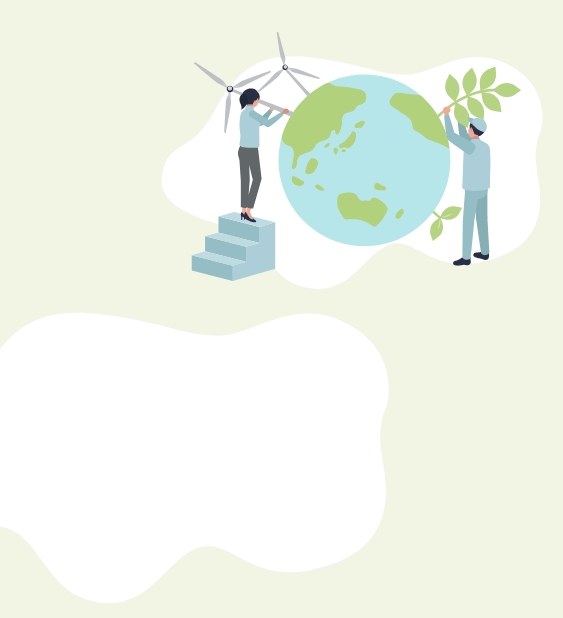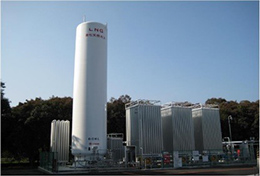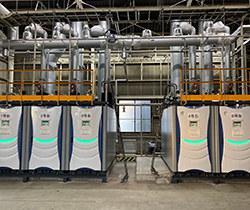
Environmental Targets and Results
We will ensure compliance with laws and regulations so that the global and natural environments are properly preserved and future generations can inherit a rich global environment. At the same time, we will meet the expectations of our stakeholders and local communities by promoting energy efficiency and conservation, reducing greenhouse gases, promoting green procurement, reducing waste, and promoting recycling in our business activities.
Climate-related Targets
We aims to achieve carbon neutrality (Scope 1 and 2) by 2050 with net-zero GHG emissions, and to reduce Scope 1 and 2 emissions by 46% compared to 2013 levels by 2030.
Initiatives to reduce environmental impact
Promoting energy efficiency and conservation and reduction of greenhouse gas emissions
Business classification system based on the Act on Rationalizing Energy Use
In accordance with periodic reports submitted to the Ministry of Economy, Trade and Industry for FY2024 under the Act on Rationalizing Energy Use, our business received a Class A rating, indicating the expectation for further efforts in energy efficiency and conservation.
Fiscal year for submission 2022 2023 2024 Most recent year-on-year change in energy intensity 97.2% 121.5% 95.6% Average over five years 99.4% 104.0% 104.0% Class A A A As of October 7, 2025
Energy conversion to liquefied natural gas (LNG)
Since 2009, the Harima Plant has been operating its boilers using liquefied natural gas (LNG) in place of heavy oil to mitigate CO₂ emissions. In 2011, we registered for the domestic credit system certification* (currently the J-credit system) and transferred a total of 15,000 tons of CO₂ reduction between 2010 and 2017.
By utilizing the generated credits, we promote low-carbon investment and expand Japan's greenhouse gas emission reductions.
LNG tank Energy efficiency and conservation activities
- We have established a working group dedicated to the continuous promotion of energy efficiency and conservation activities.
- At our Harima Plant, we updated our boilers, achieving an efficiency improvement of 6.4%. With this update, we anticipate a reduction in CO₂ emissions by 244 tons annually. This project was selected for a subsidy as part of the Advanced Energy Conservation Investment Promotion Support Project.

Promotion of recycling
The NAGASE Group’s environmental policy promotes resource conservation, including the reduction of energy and water usage, as well as waste reduction and recycling.
In alignment with this policy, we are working to realize a circular economy that balances economic growth with environmental impact reduction. Our initiatives include controlling the concentration of chemical ingredients used in semiconductor and flat panel display manufacturing processes to extend their lifecycle, reducing chemical usage, and reusing spent chemicals through distillation.
Promotion of green procurement
The basic principle for the management of hazardous chemical substances at our company is not to allow prohibited substances into our offices/factories, that is, not to manufacture prohibited substances and not to purchase raw materials containing prohibited substances.
We have established an organization specializing in chemical substance management to comply with domestic regulations and various laws and regulations, including the EU RoHS Directive and industry and customer requirements. We are working to reduce the environmental impact of our products by voluntarily reducing or eliminating the use and discharge of chemical substances where there is concern about their environmental risks.
Biodiversity conservation
We conduct our business activities in accordance with the NAGASE Group’s Basic Approach to Biodiversity and its Business Activity Policies.
Human and corporate activities can have various impacts on local ecosystems. As part of our commitment to creating a safe, secure, and warm society where people can live comfortably, we have long supported local greening initiatives.
The NAGASE Group sets voluntary environmental standards that are stricter than those required by laws, municipal regulations, and agreements related to pollution prevention, and strives to comply with them as part of its basic approach to pollution control.
In line with this approach, we maintain rigorous control over wastewater discharged from our manufacturing sites to fulfill our responsibility to protect the environment and biodiversity of rivers, watersheds, and marine areas.
Basic Approach to Water Resources
The Sustainable Development Goals (SDGs) established and promoted by the United Nations include securing a stable supply of water and richer lifestyle, including access to water for all people.
Here, the NAGASE Group works to rigorously reduce, reuse, and recycle in its business activities, striving to improve its use efficiency and reduce its usage volumes.
Especially in areas with high water stress, we take measures according to the details of the risk by analysis using the Water Risk Filter (WRF).
Water Resource Management
Water intake
All of our sites draw water from third-party water supplies. In addition, the Harima Plant also draws water from groundwater.
Water drainage
Due to the geographical conditions of the site, water is discharged into the river basin at the Harima Plant. At the time of discharge, we promote various measures, such as reducing the pollution load to improve the water environment and set management standards to maintain the quality of wastewater so that it conforms to environmental standards.
Recycling
Condensed water after steam generation is reused for boiler water supply at several sites. Recycled water is also used for cooling in water-cooled chillers.
Engagement to conserve water quality at production sites
In the water risk assessment (basin risk) of manufacturing sites conducted in fiscal year 2025 using the WWF Water Risk Filter, the Harima Plant was evaluated with a basin risk score of 2.56.
One of the Largest ozone-generating wastewater treatment facilities in Japan
We treat wastewater generated from our manufacturing processes using advanced wastewater treatment facilities, and discharge it into rivers only after ensuring that the water quality meets or exceeds regulatory standards. As part of our effort to reduce our environmental impact, we have continuously improved and upgraded our wastewater treatment methods and facilities. Wastewater that could not be fully purified in the past and was treated as industrial waste is now purified on-site to reduce environmental impact through waste reduction. Furthermore, we have introduced an Advanced Oxidation Process (AOP) facility utilizing ozone technology to prevent the discharge of wastewater that exceeds regulatory limits in the event of a COD level increase.
Utilization of well water (groundwater)
The NAGASE Group considers the 3Rs of water—reduce, reuse, and recycle—to be important initiatives for conserving limited water resources.
At our Harima Plant, located in the Ibo River basin where groundwater is abundant, we use groundwater with a stable temperature throughout the year as cooling water in our manufacturing processes.
We also promote the 3Rs of water at our manufacturing sites by cascading the use of cooling water as cleaning water in other processes.
Reducing Environmental Impact through Products
We have identified the following material issues: “Transform our chemical plant into an environmentally-friendly facility.” and “Creating a brighter future through chemical materials and technology development.”
We view environmental risks, including climate change, not only as challenges but also as opportunities to drive our business forward.
Involvement in development and sales of advanced materials
We supply epoxy resin products to Toyota Motor Corporation. Toyota's hydrogen-powered MIRAI is equipped with a high-pressure hydrogen tank, which is made of strong carbon fiber reinforced plastic (CFRP). Our epoxy resin products are used as matrix materials to impregnate carbon fibers, contributing to improved tank productivity.
Joint Development of Adult Disposable Diapers with Bio-based Super Absorbent Polymers
We have succeeded in developing a highly bio-based superabsorbent polymer (SAP) with a higher proportion of bio-derived raw materials, while maintaining the same or better water absorption performance as conventional products.
Currently, we are jointly developing products that use this biodegradable SAP as an absorbent material in disposable diapers.
The practical application of environmentally friendly hygiene products using high-biomass SAP represents a pioneering initiative. We aim to expand these sustainable products into markets such as nursing care and medical facilities, as well as drugstores.
Environmental education
We conduct regular training for all employees every year to educate them about ISO 14001 and the environment. We also provide necessary training in a timely manner, such as new employee training, training by job level, and when laws are revised.